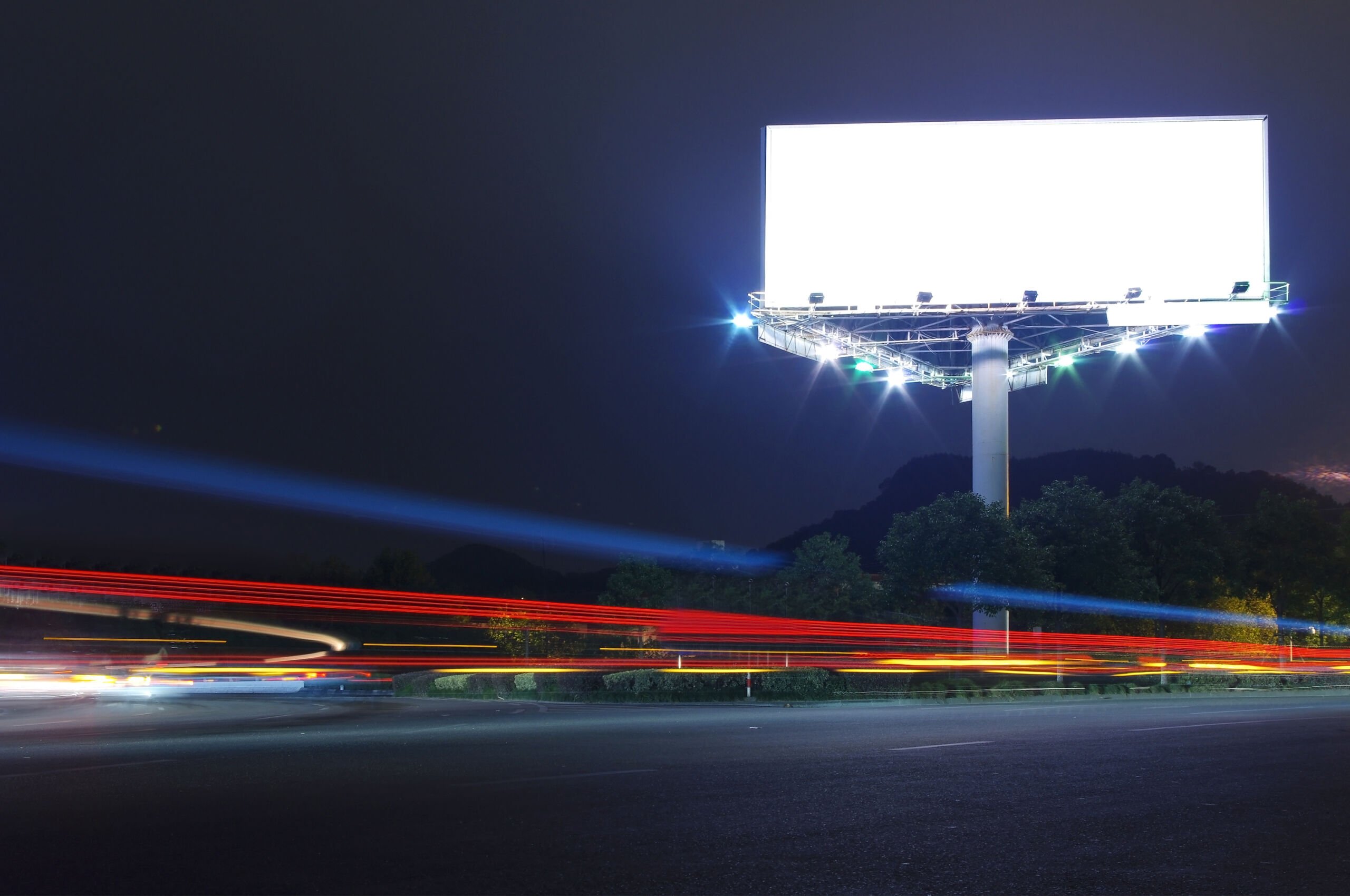
Electronic billboards, electronic message centers

When most of us think about LED billboards, we imagine ourselves in a bustling urban space like Times Square in New York City, looking up at flashing advertisements. But the same technology, also known as electronic message centers (EMC), has recently begun to dominate the outdoor advertising industry. These signs and billboards are appearing along suburban and rural roadsides and on urban buildings around the world.
Electronic billboards can be up to ten times brighter at night than traditionally lit billboards and can be harmful to the nighttime environment. The LEDs in EMCs is not shielded, so the light is emitted in all directions, including flooding into the night sky, which wastes energy and contributes to light pollution. Light from EMCs can cause glare and be a dangerous distraction to drivers. In some cases, the light from EMCs can be visible from long distances and may affect breeding, foraging, and orientation behaviors in nocturnal wildlife.
However, when installed and operated in accordance with DarkSky’s guidelines, EMCs replacing traditional floodlight-illuminated billboards can actually create a net reduction in sky brightness.
Origin
The DarkSky Technical Committee developed EMC guidelines to provide planners, lighting designers, architects, biologists, government officials, and the general public with solutions for EMCs, both on and off premises, that minimize harm to the natural night and even reduce sky brightness when replacing poorly designed lit signs and billboards. The guidelines were published in January 2019.
Summary
The guidelines…
- Recommend best practices for the amount of light emitted by electronic billboards and signs for urban, suburban, and rural areas.
- Recommend curfews for when signs and billboards should be turned off.
- Identify best management practices to decrease or eliminate negative impacts on the environment, reduce visual clutter, and improve safety for drivers and pedestrians.
DarkSky International’s guidance for electronic message centers
Purpose
Electronic message centers (EMCs) are also known as “LED signs,” “LED displays,” “solid-state lighting signs,” “digital billboards,” “mobile digital billboards,” “changeable message signs,” “media facades,” “media towers,” “architectural lighting facades,” and “electronic signs.”1 The guidance provided below addresses outdoor installations as well as indoor installations that are intended to be viewed from outdoors, such as through store windows. This guidance addresses all EMC installations no matter where situated, whether off or on a public right of way, and whether on- or off-premises.
EMCs have directly viewed arrays of LED light sources (and potentially fiber optic or backlit-display light sources) that are electronically controlled to display fixed or dynamic messages. Each LED in the array can be of a different color and brightness and is dynamically controlled. EMCs have been rapidly adopted for commercial sites and advertising. The nature of EMCs means that they will have a significant impact on the natural and built environment, often producing glare, light trespass, and sky glow and substantially changing the nightscape.
To address deficiencies in many sign codes that only address legacy sign installations, DarkSky has developed minimum requirements and a set of best practices for EMCs in order to minimize the environmental hazard that often results from carelessly installed and operated signs. These recommendations are intended to be integrated by planners into existing sign ordinances and zoning codes and adopted by lighting practitioners. While DarkSky does not endorse the use of EMCs at night, it recognizes that these installations will continue to be developed and installed widely. DarkSky therefore presents the following guidance from a technical and scientific standpoint.
Background
The light-emitting diode (LED) is transforming the way we light our cities and towns. LEDs have now come to dominate the outdoor advertising industry, replacing legacy signs such as conventional flood-lighted billboards, exposed-lamp signs, and internally illuminated (i.e., backlit) translucent signs, as well as ushering in new communication media. EMCs are appearing with increasing frequency along roadsides and on urban buildings worldwide.
EMCs consist of arrays of many thousands of programmable LED light sources that, when viewed from a distance, make up a composite picture. Multiple advertisements can be displayed in one space and altered remotely. EMCs can be adjusted by time of day, traffic conditions, and ambient light conditions, and may require less electricity than legacy installations given the high efficiency of LEDs. However, EMCs are often being applied in novel ways that expand their application and may not be replacing a traditional sign or facade light on a one-for-one basis; thus, they may not represent any energy use reduction over past practices.
EMCs can be harmful to the nighttime environment. Much of the implementation of this medium to-date has been uncontrolled, has been especially harmful to the environment, and has garnered much public attention. Unlike luminaires (i.e., light fixtures), EMC light emissions cannot at this time be shielded, and the horizontal arrangement of their LEDs — typically aimed outward toward traffic and viewers — means that some of their light is necessarily emitted laterally into adjacent environments and upward into the night sky.
Light that is emitted laterally can be a substantial source of glare, temporarily limiting visual function for passing observers. Animated and/or rapidly cycling messages can be distracting to drivers, cyclists, and pedestrians and are suspected of being a potential traffic safety risk.2
The light emission of EMCs can generate more lateral and upward light emission than conventional billboard lighting and thus can be visible to wildlife over long distances,3 affecting breeding, foraging, and orientation behaviors in individuals, potentially leading to population level impacts. EMCs may contribute substantially to light trespass4 into residences and may thus have an impact upon human health. The primary method of mitigation is through luminance control, limiting hours of operation, and avoiding locating signs adjacent to sensitive areas or residential areas.
Measurement of EMC brightness is different from most other outdoor lighting measurements. The important metric for EMCs is their luminance — the luminous intensity of the light leaving the sign surface in a given direction, as opposed to most other lighting, which is often quantified by its illuminance — the light falling upon a surface, such as the billboard face or the ground. Proper installation, regulation, and monitoring of EMCs requires the proper use of a luminance meter, and may require new measurement tools and procedures. Measurement of EMCs is discussed later in this guidance.5
DarkSky has developed this document to provide planners, lighting designers, architects, biologists, government officials, and the general public with a basic understanding of the environmental hazards and potential solutions to making EMCs less obtrusive and more sustainable. This guidance is particularly well suited for municipal planning, regional planning, transportation planning, law enforcement, code enforcement, and conservation efforts where a lighting specialist may not be available. For those lighting professionals seeking additional guidance, technical standards from organizations like the International Commission on Illumination (CIE) and Illuminating Engineering Society (IES) can be layered atop this guidance.
Guidance for electronic message centers (EMCs)
Minimum Requirements
It is impractical to shield light from EMCs due to its orientation, so many of the traditional approaches to reducing the impacts of artificial light at night do not translate to EMCs. As a result, the potential harm of EMCs cannot be completely mitigated by design alone. Rather, minimizing the harmful effects of EMCs is best accomplished through careful operation, programming, and location of this technology to the greatest extent practical. Since 2019, it has been common for EMCs to operate during the daytime at luminances in excess of 5,000 candelas per square meter (cd/m2), also known as “nits.” Such high luminances are necessary for visibility due to the high ambient illumination during the day. Achieving proper lighting control at night requires dimming of the LEDs to correspond to the lower ambient illumination and thus render more appropriate visibility. However, sufficient dimming at night is infrequently implemented, resulting in excessive brightness, decreased sustainability, and attendant environmental impacts.
These Minimum Requirements for urban, suburban, rural, and natural environments have been developed by practicing scientists and lighting engineers to provide a minimum level of protection to the nighttime environment while meeting the needs of advertisers. However, DarkSky strongly recommends also applying the Best Management Practices described further down on this page, in addition to these Minimum Requirements, to provide greater protection of the nighttime environment and to meet the currently accepted standards of sustainability.
1. Luminance level — During the nighttime hours, which commence no later than one hour after sunset, measured luminance levels shall not exceed the maximum values provided in Table 1.7
Table 1. Maximum Recommended Luminance, by Lighting Zone
| Lighting Zone | Nighttime Maximum Luminance (cd/m2) |
| LZ0 | 0 |
| LZ1 | 20 |
| LZ2 | 40 |
| LZ3 | 80 |
| LZ4 | 160 |
2. Curfew — EMCs shall be switched off completely after 2300 h (11:00 p.m.) or 30 minutes after the close of business for on-premises signs, whichever is later, and shall remain off until one hour before sunrise. EMC applications for traffic and safety information shall be exempt from curfew.
Best Management Practices
A number of best management practices (BMP) are recommended for EMCs to further decrease the negative impacts to the environment, reduce visual clutter, and improve the safety of drivers and pedestrians. The combination of adoption of these Minimum Requirements and Best Management Practices has the potential to result in no net increase, and perhaps even a net reduction, in light pollution caused by signage while simultaneously meeting the needs for commerce. Thus, DarkSky strongly supports the incorporation of the following Best Management Practices into the relevant codes and regulations covering signs and/or outdoor lighting.
BMP 1. Monitoring — The EMC device owner or the permit holder should continuously monitor signs 24 hours per day, including monitoring of the reliability of hardware, software, network, and other support infrastructure. Should a problem occur, the EMC shall remain unlit.8
BMP 2. Sensitive area setback — EMCs should not be placed within or adjacent to sensitive areas. These may include but are not limited to natural areas, beaches, wetlands, state and national parks, wildlife refuges, residential areas, observatories, and military training grounds. Setbacks in excess of 1,600 meters (one mile) from sensitive areas may be warranted.9 Distance setbacks should be assessed on a case-by-case basis, considering the cumulative effect of multiple EMCs, and set forth by the appropriate authority in each community. Mobile EMCs should be addressed as well.
BMP 3. Distraction limitation — Messages appearing on EMCs should minimize distraction to vehicle operators and pedestrians by setting a minimum message duration, setting a maximum transition time between messages, and maintaining adequate spacing between EMCs along thoroughfares.10
BMP 4. Gradual brightness reduction — It is recommended that EMC luminance levels gradually dim between daytime and nighttime modes (from sunset to one hour after sunset) to provide the proper contrast ratio with the ambient illumination level, and similarly before sunrise.
BMP 5. Size limits — Larger EMCs have a proportionally greater impact upon the nighttime environment. While DarkSky does not recommend a maximum size due to the diversity of EMC uses, it may be appropriate for planners to carefully assess the maximum size of the illuminated area in the relevant code or regulation.
BMP 6. Density limits — Because of the rapid adoption of EMCs, the cumulative impact on the environment of multiple installations should be addressed. The total light emissions from EMCs can be controlled through limiting the number or combined size of signs that are permitted for a given length of roadway or a given area of land.
Measurement
The ideal opportunity to measure luminance from an EMC is at the point of installation. Verification from the manufacturer of meeting the above recommended Minimum Requirements is strongly encouraged, in combination with “as installed” measurements. Luminance measures should be of a white screen at the programmed nighttime brightness level. Once installed and operating normally, it is substantially more difficult to obtain accurate luminance measures.
Accurate luminance measurements require care in the collecting of data, and are more difficult to conduct correctly than the more common measurements taken with an illuminance meter (a.k.a. lux meter, footcandle meter, or light meter). Proper setting of the luminance meter, a perpendicular viewing angle, and control of stray light from other sources are critical considerations. A good primer on this topic is Alex Ryer’s “Light Measurement Handbook,” which is widely available online.
Guidance on collecting luminance measurements:
- Measure between one hour after the sunset and one hour before sunrise (use the official daily sunset and sunrise times).
- Take measurements in dry, cloudless weather conditions. Rainy, foggy, or snowy conditions will result in erroneous measurements.
- The luminance meter should view the EMC perpendicular to the surface and should be aimed at the center of the EMC.
- The luminance meter should be carefully aimed or mounted on a tripod; at least five replicate measurements should be taken and the median (middle) value utilized.
Once installed and operating, the non-static images and different color compositions on EMCs, as well as their mounting height, will dramatically complicate the measurement process. Therefore, every attempt should be made to verify compliance with DarkSky Minimum Requirements using the night-mode white screen setting, and to do so before normal EMC operations. Should there be a need to evaluate an existing installation or reevaluate an installation, there are some tools that can be used to provide an approximate measure of luminance.
A standard luminance meter used on moving color images will likely produce a measurement that is lower than the actual luminance, due to shifting images and non-white colors (even when the luminance meter is set to peak luminance mode).
Smartphone applications have the potential to aid in this regard, yet there are no ideal solutions as of 2018.11 Illuminance meters, also known as footcandle or lux meters, can also be used to derive an approximate measurement of luminance, yet are prone to bias from other sources of light, and distance from the EMC must be precisely known.12 Such alternative measures may indicate whether the EMC is grossly out of compliance or not, but will subsequently require that the EMC owner or vendor be contacted to set a pure white screen for proper measurement using a luminance meter and measurements coordinated with the appropriate code enforcement office.
Revisions
Due to the rapidly evolving technology and implementation of EMCs, these Minimum Requirements, Best Management Practices, and, in particular, measurement guidance in this document may be periodically updated and improved.
Endnotes
1. DarkSky uses an expansive definition for EMCs, and does not differentiate between signs used for advertising vs. other uses, nor does DarkSky differentiate between on-premises signs and off-premises signs.
2. Dukic, T; Ahlstrom C; Patten C; Kettwich C; Kircher K. “Effects of Electronic Billboards on Driver Distraction.” Traffic Injury Prevention. 2003;14(5):469-476. DOI:10.1080/15 389588.2012.731546.
3. Luginbuhl, C; Boley, P; Davis, D. “The impact of light source spectral power distribution on sky glow.” Journal of Quantitative Spectroscopy and Radiative Transfer. 2014;139:21-26. DOI:10.1016/j.jqsrt.2013.12.004.
4. Ho, C; Lin, H; Huang, K. “A Study on Energy Saving and Light Pollution of LED Advertising Signs.” Applied Mechanics and Materials, 2011;121-126:2979–2984. DOI:10.4028/www.scientific.net/AMM.121-126.2979.
5. For example, IES Recommended Practice for Off-Roadway Sign Luminance (ANSI/IES RP-39-19).
6. IDA-IES Model Lighting Ordinance (MLO) with User Guide (2011);
7. As a point of comparison, conventionally lit signs are typically illuminated to surface brightnesses of between 60 and 100 cd/m2. See C.B. Luginbuhl, H. Israel, P. Scowen, J. Polakis, T. Polakis, “Digital LED billboard luminance recommendations – How bright is bright enough?” (white paper, 2010).
8. A typical Best Management Practice is for an EMC to default to an unlit black screen when more than 50% of the LED emitters have failed or are otherwise not displaying properly.
9. A full-size electronic billboard at 50 cd/m2 as seen from 1,600 meters (one mile) away illuminates the landscape nearly three times greater than the planet Venus (the “evening star”), and is capable of casting a visible shadow and causing glare for an otherwise dark-adapted human observer. Since EMCs generally produce a range of colors, a broad range of wildlife may be impacted, giving further credence to the requirement for substantial setbacks from sensitive areas.
10. IES Recommended Practice for Off-Roadway Sign Luminance (ANSI/IES RP-39-19) recommends a minimum duration of at least 20 seconds. Other best practices to reduce distraction include transitions from one message to another in less than 0.5 second, and to require a minimum of 366 meters (1,200 feet) between installations on roadways.
11. For example, the Candela app is no longer available.
12. DarkSky disagrees with the 2016 recommendation by the International Sign Association that EMC compliance measurements should use illuminance (footcandles or lux) instead of luminance (candelas per square meter or nits). With EMCs becoming increasingly popular, enforcement efforts should use the proper tool, and the growing market for luminance meters is bringing down the cost of these more accurate tools.
Downloads
If you have questions about these guidelines, please contact us.



















